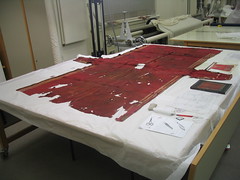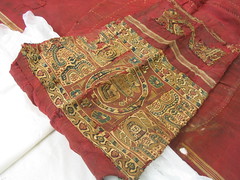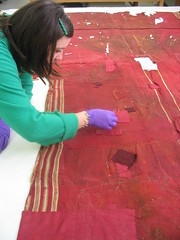By Stuart Frost
With over 1800 objects to prepare for installation in the Medieval and Renaissance Europe galleries in autumn 2009 it isn’t surprising that there is a enormous amount of activity taking place behind the scenes at the V&A.
 Each object destined for the new displays will have been the focus of many different meetings and discussions before it finally takes its place in the galleries. How should the object be mounted, at what height and in which position? Which objects should be displayed with it and of these which is the most important? Does the object need additional lighting, and if so which is the best strategy for this object? How long can the object be displayed for? Which aspects of the object are the most important to engage the visitor with? Where should the labels go and what additional graphics may be required?
Each object destined for the new displays will have been the focus of many different meetings and discussions before it finally takes its place in the galleries. How should the object be mounted, at what height and in which position? Which objects should be displayed with it and of these which is the most important? Does the object need additional lighting, and if so which is the best strategy for this object? How long can the object be displayed for? Which aspects of the object are the most important to engage the visitor with? Where should the labels go and what additional graphics may be required?
Every object will undergo a conservation assessment. Many objects have already been assessed and as a result some of the larger artefacts have been undergoing conservation work for well over a year. There are two particularly interesting objects in the Textiles Conservation Studio at the moment. One is a large tapestry featuring a scene from the Trojan War – I’ll write about that later. The other textile is a remarkable survival, a tunic of red wool with appliqué tapestry decoration. This is shown in the photograph above laid out in the studio for assessment, inspection and study. The tunic has been opened out to show the inside of the garment. If you look closely you may notice areas of brown staining on the back of the garment. The tunic was used to a dress a corpse and as the body decayed the fluids seeped through the woven woollen threads of the textile.
 The tunic was worn by a man who lived and died in Egypt at some point during the seventh or eighth century AD. The image to the left shows a detail of the tapestry decoration. The colours are remarkably vivid for a textile of this date. You can see in the other images here that the tunic has been patched and repaired in recent times. Some repairs may be ancient and careful study of the stitching has already yielded a great deal of information. For example, in antiquity the areas of tapestry decoration may well have been taken from an old tunic and reused on the front of this one. Click on the images for a closer view and additional information about what you can see.
The tunic was worn by a man who lived and died in Egypt at some point during the seventh or eighth century AD. The image to the left shows a detail of the tapestry decoration. The colours are remarkably vivid for a textile of this date. You can see in the other images here that the tunic has been patched and repaired in recent times. Some repairs may be ancient and careful study of the stitching has already yielded a great deal of information. For example, in antiquity the areas of tapestry decoration may well have been taken from an old tunic and reused on the front of this one. Click on the images for a closer view and additional information about what you can see.
 Tunics were a long-standing fashion in Roman and Byzantine dress and one that was adopted in Egypt. Close inspection of the tapestry shoulder-bands on this example has revealed the name of Allah in Arabic script, perhaps indicating that the male owner was a Muslim. Arab armies conquered Egypt in AD641 but Roman and Byzantine fashions like this co-existed alongside those of the new rulers for a long period of time.
Tunics were a long-standing fashion in Roman and Byzantine dress and one that was adopted in Egypt. Close inspection of the tapestry shoulder-bands on this example has revealed the name of Allah in Arabic script, perhaps indicating that the male owner was a Muslim. Arab armies conquered Egypt in AD641 but Roman and Byzantine fashions like this co-existed alongside those of the new rulers for a long period of time.
Conservators and curators have been making the most of the opportunity to study the tunic in detail, and the results of this close scrutiny will be fed into the new displays. You can see textile conservator Elizabeth-Anne Haldane at work in the picture to the right and curator Helen Persson is also currently researching the object. My thanks to both of them for taking the time to talk to me about the tunic.
In 2009 the tunic will be a centrepiece of a new subject display, Adorning the Dead 300-900, which will provide a moving insight into life in early medieval Europe through the objects that people were buried with. If you have any questions that you’d like to ask about the tunic post them below and I’ll do my best to obtain answers for you.
This is a fascinating post. Thanks for a look into such a rare object. Is the tunic to be on permenant display? I’m always curious about how museums figure out the balance between accessibility (showing their collections, and providing enough light to see the textile’s details) and preservation (limited light to help reduce the strain on fragile textiles).
Dear Jill,
The intention is to keep the tunic on display as long as possible – it will certainly be out in the case for a signficant period of time. I hestitate to use the word permanent but essentially in museum terms I think its reasonable to consider it a permanent display.
The case has been carefully designed / positioned to minimise the impact of daylight. The case will also have lighting that will be activated by a motion sensor – the lights in the case will only emit light when someone is looking at the objects.
There are other textiles going into the case, including a sock!
I am working with someone on a reproduction spinning and weaving project with a historical group. We are very interested in intimate details of the fiber, fabric and construction of this piece. Some things we would like to know:
* Have you determined the composition of the wool? Species and breed, origin, micron count, fiber length, grease content, etc.
* Do you know what was used to dye the wool?
* What was the yarn like? weight and thickness, worsted or woolen, etc. Was a different fiber used for the sewing or embroidery, warp or weft?
* How was it assembled? e.g.: What was the weaving width. It looks like it is a rectangle with sleeves tacked on, were there gores or gussets?
* In addition, anything you find interesting that I may not know to ask. :-) We are interested in any sources like this we can find out about. Thank you for putting this online!
To see a film about the conservation of the tunic follow the link given below:
http://www.vimeo.com/6175424